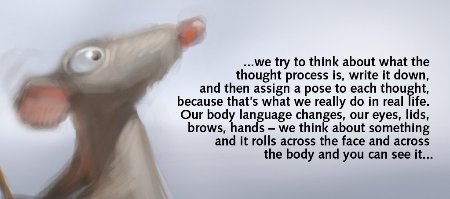Rhett Wickham: Every Little Thing That Goes Into the Soup
Page 4 of 4

Click here for a much larger version of this picture
RW
And there’s lots of negative space and dark, dark positive spaces. I love the moment when Remy comes back from under the bridge having rethought Linguini’s proposal – that shadow of the bridge is a hard, thick, black line the has a more painterly quality than other environments and backgrounds have had previously. It’s so terrific, because instead of seeing him make the approach, I see him come out of a complete, pitch black darkness and step into light in the blink of an eye.
MW
Those blacks were a big deal to us. We usually don’t have blacks like that in Pixar movies. I remember being in digital dailies of that scene, and Brad Bird just said “Look at that black!! Can you believe it!!?�? He stopped the meeting and just lost it over the fact that we had a black black. We take that for granted in CG, and it’s evolving, and the tools are evolving, and I think what you’re seeing is that everyone is practicing, and they’re all getting better at it, film after film. I’m really excited about it. Some of these guys that made huge leaps in their animation quality on Ratatouille, I think where are they going to be in another five years!? It gives me a lot of hope for the future.
RW
Me too.
MW
The medium is new, but the people are getting better along with the technology, and I think it’s advancing at a rate that’s faster than what I thought it would.
RW
Is there anything in which you think 2D still excels over CG?
MW
I see the art more in 2D, personally. I feel likes there’s more art in it. That’s not to say that there is no art in CG, because there definitely is, like when you watch The Muppets – you’re aware when you’re watching Grover that he’s a puppet, and there’s a joy I get out of constantly reminding myself that I’m watching a puppet but not caring. Now, I think in CG you can get that, and in Ratatouille we have that, but I think because it still can look so real you may not be as aware of that as you are with 2D when you know it’s a drawing, clearly a series of drawings, and that’s what makes it so fantastic. The craft is apparent, but with CG you’re almost blind to it. I’m hoping 2D will go into an area where it will show off what it is, rather than try to hide the lines.
RW
But I have to say that I think that in Ratatouille there is a lot of that. The extremes are wonderfully rubbery, and there is some awareness of the artistry.
MW
Then maybe the problem is not 2D or not 2D, the problem is that, from an animator’s standpoint – not a story standpoint – the problem is where people are coming from. What I mean is that it is a series of drawings, but if you look at the best of the Nine Old Men – as Ollie would say – it’s not about the drawing, it’s about what’s underneath the drawing. It’s about the thought process.
I think it’s lost throughout the new generation. People are so into the fact that it’s moving. And it’s so easy to do now. You can get software, get a 3D program and start moving something around and “look, I’m an animator!�? But to think about things, the way those guys thought about it, to get through to a character … when Ollie came here we were showing him a little bit of the film, and we were showing him the software and how we did it. He said, “That’s nice. But what happens first?�? And we said, “Well what do you mean?�? And he said, “Before you do all that, before you move it around, what happens first?�?
He was very quizzical and sort of upset, and I said, “Well we try to think about what the thought process is, write it down, and then assign a pose to each thought, because that’s what we really do in real life. Our body language changes, our eyes, lids, brows, hands – we think about something and it rolls across the face and across the body and you can see it. So if you think about what the character is thinking and assign poses to that so that the audience can see without talking what the character is thinking. Then the character comes alive.�?
I looked at his eyes and he smiled, and he nodded and said, “That’s what I wanted to hear.�?
The complete interview is available in Issue #10 of Tales from the Laughing Place Magazine.
Discuss It
-- Interview by Rhett Wickham
-- Posted July 27, 2007
